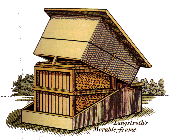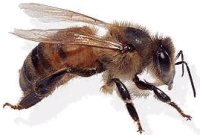BEEKEEPING IN HISTORY
The earliest known hives built specifically to house the honeybee appear in Ancient Egyptian paintings dating from 2,500 B.C., showing how the Egyptians had progressed from making raids on wild bees' nests to the systematic removal of honey from man-made hives.
These primitive hives were formed from rows of hollow tubes made from baked clay in which the bees made wax comb and then filled it with honey. This cylindrical design was later adopted by the Greeks and Romans. Over the centuries man has used locally available materials such as clay, wicker, straw or logs to construct hives, often copying the form of wild bees' nests. Many African villagers still imitate nature by keeping bees in hollow logs, although these are hung horizontally rather than vertically.
Although beekeeping was established in Britain before the Romans came, it was not until the last century that beekeepers developed hives from which they could remove the honey without destroying the honeycomb

The big breakthrough came with the recognition by the American minister Lorenzo Langstroth that honeybees left passageways in their combs so that they could get to each wax cell to fill it with pollen or nectar. Langstroth realised that this "bee space" would have to be included in the design of man-made hives, otherwise the combs would become firmly fixed to each other and could not be removed without killing the bees. He pioneered a design, still in use today, in which all the frames in the hive are completely removable.
Modern hives have removable wooden frames fitted with pre-formed wax comb foundation. The use of these fabricated wax sheets bearing the hexagonal imprint of a natural bee cell gives the bees a head start in the construction of honeycomb and results in higher yields of precious honey.
